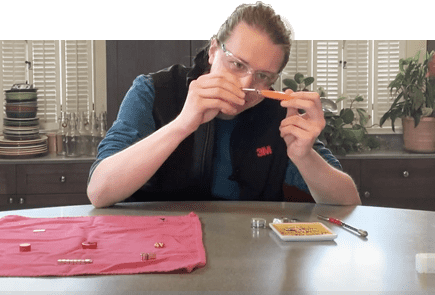A jetliner can weigh over 300 tons, so why doesn’t it just drop out of the air? Denise Rutherford explains the Bernoulli principle and how without it, planes (and birds) couldn’t fly.
Background
Daniel Bernoulli was a Swiss scientist and mathematician who documented important scientific principles in the eighteenth century. Particularly interesting was his work in fluid dynamics, by which the Bernoulli Principle was discovered. While Bernoulli discovered that pressure decreases when the flow speed increases, it was actually a man named Leonhard Euler who figured out Bernoulli's equation in 1752. Nevertheless, Bernoulli's work influenced pivotal technology that has changed our world forever, from carburetors in vehicles to airplane wings.
Key Concepts
- Air Pressure
- Bernoulli Principle
- Fluid Dynamics
Materials
- An adult helper
- Ping pong ball
- Hair Dryer
- Construction Paper (optional)
- Tape (optional)
Preparation
- To use the hair dryer, plug it in with the help of an adult.
- Make a prediction: What will happen to the ball when you turn on the hair dryer and place the ball in the stream of air? What about if you tilt the stream of air holding the ball up?
- Position the hair dryer so that when you turn it on, the air that comes out will be moving upwards.
- Turn the hair dryer on facing straight up and hold the ball in the stream of air. Then, let go of the ball.
- Try tilting hair dryer so the ball is floating at an angle instead of straight up and down. How far over can you tilt the hairy dryer before the ball falls out of the stream of air?
- Remember to clean up when you are done. Put the hairdryer and ping pong ball back where you found them.
Observation and Results
You should be able to tilt the hair dryer pretty far before the ball actually falls out of the column. This is because the ball is actually held in the column by the pressure of the air around it. The Bernoulli Principal tells us that moving fluids- like gasses or liquids- have lower pressure than fluids that are not moving. When you turn the hair dryer on, you are creating a column of moving air, which has a lower pressure than the air around it. When the ball starts to move out of that column, the high-pressure air outside the column pushes it back into the column. This still happens even when you tilt the column, so you can tilt pretty far before the ball starts to fall, even though it isn’t being pushed straight up by the air anymore.
The Bernoulli Principle is also what causes a shower curtain to move into the shower when you turn on the water. The moving water and air create a low-pressure space, and the high-pressure air outside the shower pushes into that low-pressure area. As it pushes, it brings the shower curtain with it, so the curtain moves toward the inside of the shower.
Build a ping pong ball launcher like in the video, using construction paper and tape.
The Bernoulli Principal works with all fluids- both liquids and gasses. To see the Bernoulli Principal work in liquids, try floating some cereal like Cheerios about two inches apart in a bowl of water, and pour a small stream of water in between them. The Cheerios should move toward each other because the moving water in creates a low-pressure area.
You can also try tying two balloons to some string, and hanging them a few inches apart, and blowing in between. The balloons should move towards each other, just like the cheerios.
Safety First and Adult Supervision
- Follow the experiment’s instructions carefully.
- A responsible adult should assist with each experiment.
- While science experiments at home are exciting ways to learn about science hands-on, please note that some may require participants to take extra safety precautions and/or make a mess.
- Adults should handle or assist with potentially harmful materials or sharp objects.
- Adult should review each experiment and determine what the appropriate age is for the student’s participation in each activity before conducting any experiment.
Next Generation Science Standard (NGSS) Supported - Disciplinary Core Ideas
This experiment was selected for Science at Home because it teaches NGSS Disciplinary Core Ideas, which have broad importance within or across multiple science or engineering disciplines.
Learn more about how this experiment is based in NGSS Disciplinary Core Ideas.
Engineering Design (ETS)1: Engineering Design
Grades 3-5
- 5-PS1-1. Matter of any type can be subdivided into particles that are too small to see, but event then the matter still exists and can be detected by other means.
Grades K-2
- K-PS2-1. Pushes and pulls can have different strengths and directions.
- K-PS2-2. Pushing or pulling on an object can change the speed or direction os its motion and can start or stop it.
Grades 3-5
- 3-PS2-1. Each force acts on one particular object and has both strength and a direction. An object at rest typically has multiple forces acting on it, but they add to give zero net force on the object. Forces that do not sum to zero can cause changes in the object’s speed or direction of motion.
- 3-PS2-2. The patterns of an object's motion in various situations can be observed and measured; when that past motion exhibits a regular pattern, future motion can be predicted from it.
Grades 6-8
- MS-PS2-1. For any pair of interacting objects, the force exerted by the first object on the second object is equal in strength to the force that the second object exerts on the first, but in the opposite direction.
- MS-PS2-2. The motion of an object is determined by the sum of the forces acting on it; if the total force on the object is not zero its motion will change. The greater the mass of the object, the greater the force needed to achieve the same change in motion. For any given object, a larger force causes a larger change in motion.
- MS-PS1-6. Some chemical reactions release energy, others store energy.
Grades 9-12
- HS-PS2-1. Newton's second law accurately predicts changes in the motion of macroscopic objects.
- HS-PS2-2. Momentum is defined for a particular frame of reference; it is the ass times the velocity of the object. In any system, total momentum is always conserved.
- HS-PS1-3. If a system interacts with objects outside itself, the total momentum of the system can change; however, any such change is balanced by changes in the moment of objects outside the system.
Grades K-2
- K-PS2-1. When objects touch or collide, they push on one another and can change motion.
Grades 3-5
- 3-PS2-1. Objects in contact exert forces on each other.
Grades 6-8
- MS-PS2-4. Gravitational forces are always attractive. There is a gravitational force between any two masses, but it is very small except when one or both of the objects have a large mass.
Grades 3-5
- 4-PS3-1. The faster a given object is moving, the more energy it possesses.
- 4-PS3-2. Energy can be moved from place to place by moving objects.
Grades 6-8
- MS-PS3-1. Motion energy is properly called kinetic energy.
- MS-PS3-2. A system of objects may also contain stored (potential) energy, depending on their relative positions.
Grades 9-12
- HS-PS3-1. Energy is a quantitative property of a system that depends on the motion and interactions of matter within that system.
- HS-PS3-2. Within a system, energy is continually transferred from one object to another.
- HS-PS3-3. At the macroscopic scale, energy manifests itself in multiple ways.
Grades 3-5
- 4-PS3-2. Energy is present whenever there are moving objects, sound, light, or heat.
- 4-PS3-3. When objects collide, energy can be transferred from one object to another, thereby changing their motion.
Grades 6-8
- MS-PS3-5. When the motion energy of an object changes, there is inevitably some other change in energy at the same time.
Grades 9-12
- HS-PS3-1. Conservation of energy means that the total change of energy in any system is always equal to the total energy transferred into or out of the system. Energy cannot be created or destroyed.
- HS-PS3-4. Energy can be transported form one place to another and transferred between systems.
Grades K-2
- K-PS2-1. A bigger push or pull makes things go faster.
Grades 3-5
- 4-PS3-3. When objects collide, the contact forces transfer energy so as to change the objects’ motions.
Grades 6-8
- MS-PS3-2. When two objects interact, each one exerts a force on the other that can cause energy to be transferred to or from the object.
Grades 9-12
- HS-PS3-5. When two objects interacting through a field change relative position, the energy stored in the field is changes.
Explore Additional Science at Home Videos and Activities

How Do We Breathe?
How do our lungs work?
Follow along as special guest Dakota Dozier, an offensive lineman for the Minnesota Vikings, makes a model to show how air flows in and out of the lungs with ease.

Push and Pull
Follow along with 3M’s Sam Reiss, as he shows you that magnetism is more than just a simple push and pull – it’s an example of the power of the earth itself.

Diffusion with Miss America 2020
Ever wonder why things mix (or don’t mix) differently in different temperatures of water?
Join Camille Schrier, a scientist who was crowned Miss America 2020, as she explains diffusion and how substances move though water.

